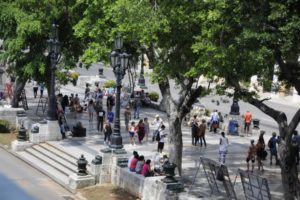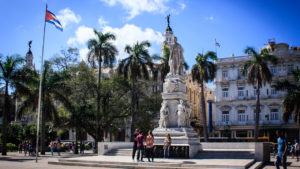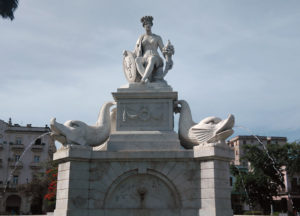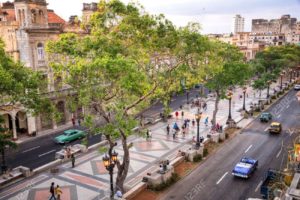 A SEMEJANZA DE MADRID Y EN SU PROPIA HISTORIA, LA HABANA TIENE SU “PASEO DEL PRADO”. FOTOS.
A SEMEJANZA DE MADRID Y EN SU PROPIA HISTORIA, LA HABANA TIENE SU “PASEO DEL PRADO”. FOTOS.
Durante la ocupación española de la Isla de Cuba y en periodos de crecimiento de la Habana hizo que la entonces capital de Cuba inaugurara su primer lugar de recreo y esparcimiento en 1772 dentro de su entonces sector amurallado, este espacio extramuros se le puso como nombre a semejanza de espanola Madrid: El Paseo del Prado.
Luego también se le llamó ‘Paseo de Extramuros’, ‘Alameda de Isabel II’, ‘Paseo del Conde de Casa Moré’ y con el advenimiento del siglo XX, ‘Paseo de Martí’, aunque para el habanero común es sencilla y llanamente: El Prado.
Similar a como lo es hoy, en sus inicios se extendía desde la explanada del Castillo de la Punta a la entrada de la bahía hasta la puerta del teatro Tacón, hoy nombrado Gran Teatro de la Habana Alicia Alonso. Posteriormente, aunque con diseño diferente, se extendió su delineado hasta la Plaza de Marte, actual Parque de la Fraternidad.
Desde sus inicios tuvo la peculiar estructura que ha conservado a través del tiempo: ancho espacio peatonal y para carruajes al centro (inicialmente de tierra) y frondosos árboles en sus bordes.
Su apariencia actual, con bancos de piedra y mármol a los lados, peculiares farolas, copas y laureles, la adquirió en una remodelación concluida en homenaje al 10 de octubre de 1928.
Los emblemáticos leones, ocho en total, observan inmóviles a los habaneros desde enero de 1929 y fueron fundidos con material de los cañones que en la época colonial defendieron la ciudad de los ataques de corsarios y piratas.
La prensa de la época también describe que era posible escuchar hasta cinco bandas de música a lo largo del recorrido y que durante las fiestas de carnavales era el punto culminante de los populares ‘paseos’, un espectáculo desbordante de color y alegría que con el tiempo dio renombre a La Habana.
Con Historia y personalidad propia.
Una vez iniciado el derribo de las murallas, en 1863, comenzó la urbanización del entorno del Prado, el cual se convirtió en zona aristocrática de la ciudad toda vez que se erigieron a ambos lados del Paseo las más suntuosas y elegantes mansiones de la clase adinerada.
Junto con las edificaciones se conformaron sus esquinas, ‘cada una con historia y personalidad propias’, asegura el historiador y periodista Eduardo Robreño Deupy en su libro ‘Cualquier tiempo pasado fue Mejor”.
El autor describe cómo en la esquina de Malecón y Prado existía desde fines del siglo XIX una glorieta que era popular por las retretas ofrecidas cada tarde por la Banda del Estado Mayor del Ejército, sitio de reunión para los bailadores de la época y donde se efectuaron además algunas peleas de boxeo y las primeras transmisiones radiales en Cuba.
Por su parte, en la intersección de la calle San Lázaro se levantó a finales del siglo XIX el café ‘El Tiburón’, famoso entonces por sus ofertas de bebidas europeas, básicamente ginebra.
La esquina de Prado y Cárcel debe su nombre a que allí se erigió el macizo y tétrico edificio que durante años sirvió de prisión y donde sufrieron martirio muchos patriotas habaneros por ansiar la libertad de Cuba.
Ya en el siglo XIX, una vez derribado el penal, se levantó allí un hotel en cuya planta baja se estableció la agencia de ventas de los entonces muy modernos automóviles norteamericanos Packard y Cunninghan.
Un siglo después, gracias a la restauración, se encuentra en ese sitio el flamante hotel ‘Packard’, el cual muestra, en armonía con una sobria modernidad, su fachada original.
Mientras tanto, en la de la calle Genios, llamada así por la fuente de igual nombre que estuvo enclavada durante años en esa intersección, había un espacioso caserón de tres pisos donde funcionaron durante décadas los juzgados de Instrucción y Primera Instancia de La Habana.
En la esquina de Refugio -de acuerdo con Robreño- edificó una mansión Frank Steinhart, un simple sargento de las tropas norteamericanas que escamotearon la independencia de Cuba en 1898 y que, fruto de una amañada concesión, a los pocos años ya era zar del transporte en la ciudad.
Más adelante está la bulliciosa intersección de Prado y Colón, donde aún hoy se levanta el cine Fausto, que en sus inicios fue un animado recinto de madera, sitio preferido de los primeros habaneros amantes del séptimo arte.
Justo en la esquina de Trocadero, el general José Miguel Gómez, -presidente de la República entre 1909 y 1913 que el pueblo cubano bautizó como “tiburón” por aquello de “se baña pero salpica”-, se construyó una fastuosa residencia, la cual la suspicacia popular asoció a fondos provenientes de la lotería nacional.
La siguiente calle es Ánimas, que merece detenerse un instante e inclinar la frente, porque allí permanece desde mediados del siglo XIX ?hoy con renovada belleza y sobresaliente restauración? el colegio del señor Mendive, donde se fraguaron el alma sublime y el temple patriota del más eminente de sus alumnos: el Apóstol de la independencia cubana, José Martí.
Fue en Prado y Virtudes, donde originalmente radicó el café ‘El Pueblo’ y a inicios del siglo XX se levantaron los inmuebles de los periódicos ‘La Noche’ y ‘La Nación’.
Diagonal al Parque Central, en Prado y Neptuno, se encontraba en la época colonial el ‘Bodegón de Alonso’, una especie de taberna de la que eran dueños dos ricos españoles, padre y tío de Alonso Álvarez de la Campa, uno de los ocho estudiantes de medicina injustamente fusilados por el gobierno español el 27 de noviembre de 1871.
Posteriormente, en ese mismo lugar se erigió el café ‘Las Columnas’, en alusión a la forma de sus portales y en cuya planta alta se estableció un salón de bailes donde, años después, el maestro Enrique Jorrín compuso su eterno cha cha chá La Engañadora.
Luego del Parque Central está la esquina de San José, en la que se erige el teatro Payret, convertido en cine, y en la acera de enfrente se impone majestuoso y recién restaurado, el Capitolio Nacional, símbolo de la ingeniería civil cubana.
Así, a cada paso, se siente que el Prado habanero conserva, de conjunto con la imprescindible modernidad, el sortilegio de su entorno, la hidalguía de su pasado y el ruinoso encanto de su presente.
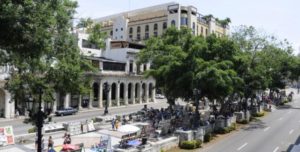 COPYING LIKE MADRID AND IN OWN HISTORY, HAVANA HAS ITS “PASEO DEL PRADO”. PHOTOS.
COPYING LIKE MADRID AND IN OWN HISTORY, HAVANA HAS ITS “PASEO DEL PRADO”. PHOTOS.
During the Spanish occupation of the Island of Cuba and during periods of growth in Havana, it made the then capital of Cuba inaugurate its first place of recreation and recreation in 1772 within its then walled sector, this space outside the walls was named similarity of Spanish Madrid: The Paseo del Prado.
Then it was also called ‘Paseo de Extramuros’, ‘Alameda de Isabel II’, ‘Paseo del Conde de Casa Moré’ and with the advent of the twentieth century, ‘Paseo de Martí’, although for the common habanero it is simple and simple: The meadow.
Similar to what it is today, in its beginnings it extended from the esplanade of the Castillo de la Punta to the entrance of the bay to the door of the Tacón theater, today named the Great Theater of Havana Alicia Alonso. Subsequently, although with a different design, its outline was extended to the Plaza de Marte, current Fraternity Park.
From its beginnings, it had the peculiar structure that it has preserved over time: wide pedestrian and carriage space to the center (initially of land) and leafy trees at its edges.
Its current appearance, with stone and marble benches on the sides, peculiar lampposts, glasses, and laurels, acquired it in a remodeling completed in tribute to October 10, 1928.
The emblematic lions, eight in all, observe the Havana people immobile since January 1929 and were fused with material from the cannons that in the colonial era defended the city from the attacks of privateers and pirates.
The press of the time also describes that it was possible to listen to up to five bands along the route and that during the carnival parties it was the highlight of the popular ‘walks’, a show overflowing with color and joy that over time He gave Havana a reputation.
With History and own personality.
Once the demolition of the walls began, in 1863, the urbanization of the surroundings of the Prado began, which became an aristocratic area of the city since the most sumptuous and elegant mansions of the wealthy class were erected on both sides of the Paseo.
Together with the buildings, its corners were formed, ‘each one with its own history and personality,’ says historian and journalist Eduardo Robreño Deupy in his book ‘Any past time was better.’
The author describes how in the corner of Malecon and Prado there was a roundabout since the end of the 19th century that was popular for the toilets offered every afternoon by the Army General Staff Band, meeting place for the dancers of the time and where they were held also some boxing fights and the first radio broadcasts in Cuba.
On the other hand, at the intersection of San Lázaro street, the ‘El Tiburon’ coffee was built at the end of the 19th century, famous for its offers of European drinks, basically gin.
The corner of Prado and Cárcel owes its name to that the massive and gloomy building was erected there, which for years served as a prison and where many Havana patriots suffered martyrdom for craving Cuba’s freedom.
Already in the nineteenth century, once the prison was demolished, a hotel was built there on whose ground floor the sales agency of the then very modern American cars Packard and Cunninghan was established.
A century later, thanks to the restoration, the brand new ‘Packard’ hotel is located on that site, which shows, in harmony with sober modernity, its original facade.
Meanwhile, on Genios Street, named for the source of the same name that was nestled for years at that intersection, there was a spacious three-story mansion where the Instruction and First Instance courts of Havana functioned for decades.
In the corner of Refugio – according to Robreño – a Frank Steinhart mansion was built, a simple sergeant of the American troops who escaped the independence of Cuba in 1898 and that, as a result of a rigged concession, a few years later he was a Tsar of transport in the city.
Further on is the bustling intersection of Prado and Colón, where the Fausto cinema still stands today, which in its beginnings was a lively wooden enclosure, a favorite site of the first Havana lovers of the seventh art.
Right on the corner of Trocadero, General José Miguel Gómez, -President of the Republic between 1909 and 1913 that the Cuban people baptized as a “shark” for that of “bathes but splashes” -, a lavish residence was built, which popular suspicion associated funds from the national lottery.
The next street is Ánimas, which deserves to stop for a moment and tilt its forehead because there it remains since the mid-nineteenth century? Today with renewed beauty and outstanding restoration? Mr. Mendive’s school, where the sublime soul and the patriotic temper of the most eminent of his students were forged: the Apostle of Cuban independence, José Martí.
It was in Prado and Virtues, where the ‘El Pueblo’ coffee originally settled and at the beginning of the 20th century the buildings of the ‘La Noche’ and ‘La Nación’ newspapers were built.
Diagonal to the Central Park, in Prado and Neptune, was in the colonial era the ‘Bodegón de Alonso’, a kind of tavern owned by two rich Spaniards, father and uncle of Alonso Álvarez de la Campa, one of the eight Medical students unfairly shot by the Spanish government on November 27, 1871.
Subsequently, in that same place the cafe ‘Las Columnas’ was erected, in reference to the shape of its portals and on whose upper floor a dance hall was established where, years later, the teacher Enrique Jorrín composed his eternal cha chá La Deceiver
After the Central Park in the corner of San José, in which the Payret theater, converted into a cinema, is erected and on the sidewalk in front is majestic and newly restored, the National Capitol, a symbol of Cuban civil engineering.
Thus, at every step, it is felt that the Havana Prado conserves, together with the essential modernity, the spell of its surroundings, the hidalguia of its past and the ruinous charm of its present.
Agencies/ RHC/ Gustavo Robreño/ Extractos/ Excerpts/ Internet Photos/ Arnoldo Varona/ www.TheCubanHistory.com
THE CUBAN HISTORY, HOLLYWOOD.



 < COPYING Like Madrid, and in Own History, La Havana has its "PASEO DEL PRADO". FOTOS.
< COPYING Like Madrid, and in Own History, La Havana has its "PASEO DEL PRADO". FOTOS.